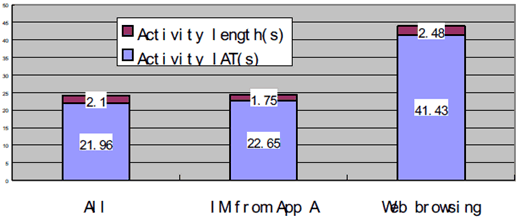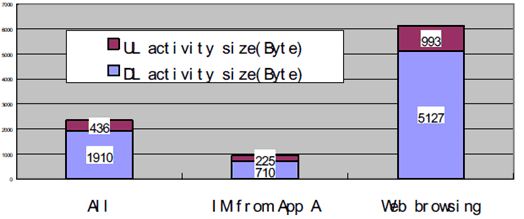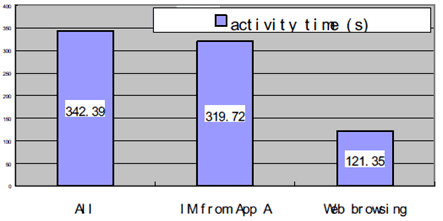Content for TR 22.801 Word version: 12.0.0
A Example for estimating frequency of Facebook content/status update messages
B Example of data traffic model for a mobile IM application
A Example for estimating frequency of Facebook content/status update messages p. 14
An example is provided on how to estimate average frequency of receiving Facebook content /status update messages:
www.facebook.com/press/info.php?statistics
¥ http://www.digitalbuzzblog.com/facebook-statistics-facts-figures-for-2010/
- # of average content items generated per user a1. 30 billion items of content generated by all users per month§ / 500 million Facebook users§ = 60 per user per month a2. average # clicks of "like" button = 9 per user per month¥ a3. average # of comments written = 25 per user per month¥ a= a1+a2+a3 = 94 content updates per user per month
- average # of friends per user = 130¥
- average number of received facebook content / status update messages per user per month = a*b = 94*130 = 12220 per month => 407.3 per day => ~17 per hour (once every 3.5 minutes)
B Example of data traffic model for a mobile IM application p. 15
The following data has been gathered from a certain data hotspot of a mobile operator's 2G GPRS network to illustrate the impact of an IM application (App A) behaviour in the mobile network.
Activity duration is the time between the first and last packets of an closely spaced activity of one usage of such service. Activity inter-arrival time (Activity IAT) is the time between two consecutive activities belonging to the same user and same traffic category. From the following Figure B-1, activity duration and activity IAT of IM from App A are shorter than other applications (e.g. web browsing), which means that users tend to use IM application more frequently, but the duration is shorter than other applications.

Activity Burst Size is the sum of all user plane payloads, including IP headers within a packet burst.
From the following Figure B-2, activity size of IM from App A is much smaller than other applications, e.g. web browsing.

Activity time is total seconds of active usage of the network for a subscriber in a busy hour. From the following Figure, IM from App A has a long activity time, which explains why it contributes to a big part of the total traffic volume despite its low intensity.

Some testing data has been accumulated in live cells of 2G GPRS network to monitor signalling failures and it was found that a considerable percentage of failures took place due to signalling channels being congested and a large number of active IM users were frequently activating and deactivating PS sessions.
Some data has also been gathered in live cells to monitor the utilization rate of bearer channels (PDCH, Packet Data Channel which is used to carry payloads). It was found that the utilization rate of PDCH deteriorated to a considerable extent, where there were a large number of active mobile IM users generating a huge number of small packets and reducing radio channel utilization rate.